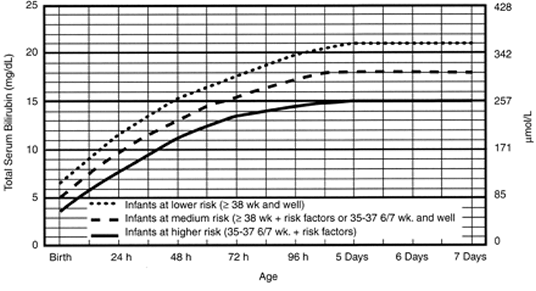Management of Hyperbilirubinemia
The goal of management is to prevent bilirubin encephalopathy or kernicterus.
- Decrease enterohepatic circulation of bilirubin by increasing fluid intake and promoting passage of meconium.
- Phototherapy: exposure to certain wavelengths of light encourages photoisomerization of bilirubin from the naturally occurring "Z" form to the nontoxic, water-soluble, excretable "E" form.
- If phototherapy is not successful in adequately reducing the bilirubin level, then exchange transfusion should be considered. For the term infant, exchange transfusion is traditionally performed at a bilirubin level of 20 mg/dl and for the preterm infant, at 14 to 15 mg/dl. For the very low birth weight premature infant weighing less than 1000 g, exchange transfusion may have to be performed at the serum bilirubin level of 10 to 12 mg/dl.
More information on managing jaundice
It is very important to determine the baby's age in hours at the time of assessment and his/her risk factors for severe hyperbilirubinemia.
An excellent reference for this process is Bilitool from Bilitool.org
Level of Risk
The Bhutani Nomogram is used to determine the level of risk based on the Infant's hours of age and serum bilirubin result.

Major Risk Factors for severe hyperbilirubinemia in infants >35 weeks gestational age:
- Predischarge bilirubin in high risk zone
- Jaundice observed in the first 24 hours of life
- Blood group incompatibility with positive direct Coomb's test or other hemolytic disease
- Gestational age 35-36 weeks
- Previous sibling with history of jaundice that required phototherapy
- Cephalohematoma or significant bruising
- Exclusive breast feeding, particularly if weight loss is excessive
- East Asian race
Guidelines for phototherapy based on infant's age, risk factors, and serum bilirubin help us determine the course of action.

Quickcheck: Jaundice
You are evaluating an infant for Jaundice on 04/27/2017 at 9am, He was born on 04/24/17 at 9pm and his Bilirubin level today is 15.5 mg/dl. He was born at 40 weeks gestational age. He had an uncomplicated pregnancy and nursery stay and he is feeding formula well.
Select the correct answer for each question
Reference
Bhutani, Vinod K., Lois Johnson, and Emidio M. Sivieri. "Predictive ability of a predischarge hour-specific serum bilirubin for subsequent significant hyperbilirubinemia in healthy term and near-term newborns." Pediatrics 103.1 (1999): 6-14.




